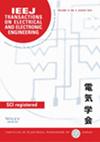Tran Hoang Nhut, Vo Pham Tan Trung, Cao Minh Khoi, Nguyen Phuoc Hoang Khang, Nguyen Chi Nhan
求助PDF
{"title":"An AIoT-Based System for Efficient Classification of Rice Leaf Diseases†","authors":"Tran Hoang Nhut, Vo Pham Tan Trung, Cao Minh Khoi, Nguyen Phuoc Hoang Khang, Nguyen Chi Nhan","doi":"10.1002/tee.70163","DOIUrl":null,"url":null,"abstract":"<p>The quantity and quality of rice output are significantly impacted by rice diseases. The accurate and fast diagnosis of rice diseases is the key to avoiding these negative effects. Recent remarkable advancements in the fields of the Internet of Things (IoT) and artificial intelligence (AI) have given rise to a novel concept known as Artificial Intelligence of Things (AIoT). In this paper, an AIoT-based system has been designed for the efficient classification of rice leaf diseases. Machine learning models have been built based on deep convolutional neural networks such as YOLO and ResNet and evaluate the capability of distinguishing healthy cases from three types of rice leaf diseases, including leaf blast, hispa, and brown spot, and healthy. Each machine learning model provides quite good classification results; however, there are still some confusion cases between types of diseases. The most optimal machine learning model was used to deploy on IoT platforms, including servers and web applications. © 2025 Institute of Electrical Engineers of Japan and Wiley Periodicals LLC.</p>","PeriodicalId":13435,"journal":{"name":"IEEJ Transactions on Electrical and Electronic Engineering","volume":"20 11","pages":"1875-1881"},"PeriodicalIF":1.1000,"publicationDate":"2025-09-11","publicationTypes":"Journal Article","fieldsOfStudy":null,"isOpenAccess":false,"openAccessPdf":"","citationCount":"0","resultStr":null,"platform":"Semanticscholar","paperid":null,"PeriodicalName":"IEEJ Transactions on Electrical and Electronic Engineering","FirstCategoryId":"5","ListUrlMain":"https://onlinelibrary.wiley.com/doi/10.1002/tee.70163","RegionNum":4,"RegionCategory":"工程技术","ArticlePicture":[],"TitleCN":null,"AbstractTextCN":null,"PMCID":null,"EPubDate":"","PubModel":"","JCR":"Q4","JCRName":"ENGINEERING, ELECTRICAL & ELECTRONIC","Score":null,"Total":0}
引用次数: 0
引用
批量引用
Abstract
The quantity and quality of rice output are significantly impacted by rice diseases. The accurate and fast diagnosis of rice diseases is the key to avoiding these negative effects. Recent remarkable advancements in the fields of the Internet of Things (IoT) and artificial intelligence (AI) have given rise to a novel concept known as Artificial Intelligence of Things (AIoT). In this paper, an AIoT-based system has been designed for the efficient classification of rice leaf diseases. Machine learning models have been built based on deep convolutional neural networks such as YOLO and ResNet and evaluate the capability of distinguishing healthy cases from three types of rice leaf diseases, including leaf blast, hispa, and brown spot, and healthy. Each machine learning model provides quite good classification results; however, there are still some confusion cases between types of diseases. The most optimal machine learning model was used to deploy on IoT platforms, including servers and web applications. © 2025 Institute of Electrical Engineers of Japan and Wiley Periodicals LLC.
基于aiot的水稻叶片病害高效分类系统[j]
水稻病害严重影响水稻产量和质量。准确、快速地诊断水稻病害是避免这些负面影响的关键。最近在物联网(IoT)和人工智能(AI)领域取得的显著进展产生了一个被称为物联网人工智能(AIoT)的新概念。本文设计了一个基于aiot的水稻叶片病害分类系统。基于YOLO和ResNet等深度卷积神经网络建立了机器学习模型,并评估了将健康病例与三种水稻叶片病害(包括叶瘟、hispa和褐斑)和健康病例区分开来的能力。每个机器学习模型都提供了相当好的分类结果;然而,仍有一些疾病类型之间的混淆情况。最优的机器学习模型被用于部署在物联网平台上,包括服务器和web应用程序。©2025日本电气工程师协会和Wiley期刊有限责任公司。
本文章由计算机程序翻译,如有差异,请以英文原文为准。


 求助内容:
求助内容: 应助结果提醒方式:
应助结果提醒方式:


